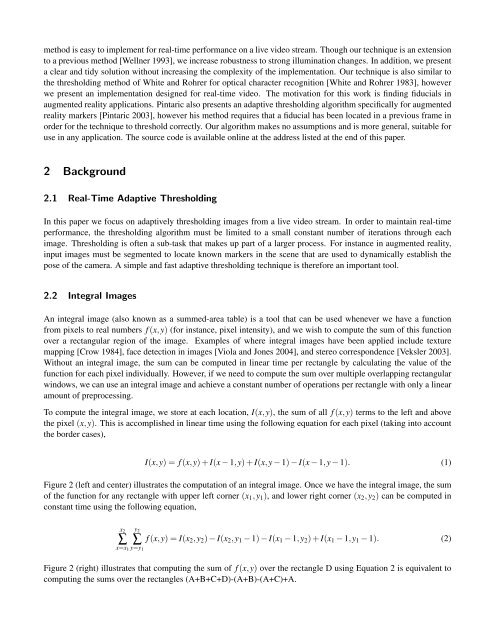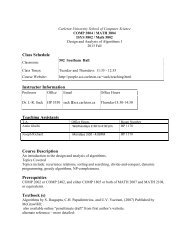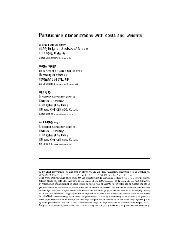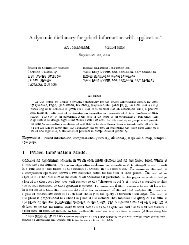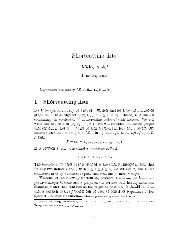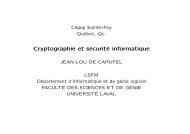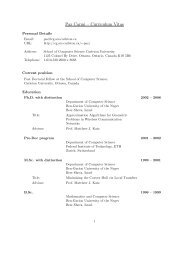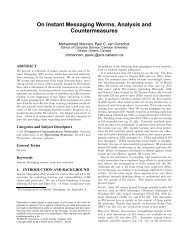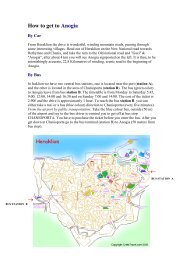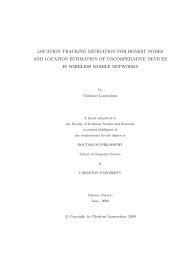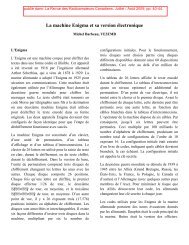Adaptive Thresholding Using the Integral Image - Carleton University
Adaptive Thresholding Using the Integral Image - Carleton University
Adaptive Thresholding Using the Integral Image - Carleton University
You also want an ePaper? Increase the reach of your titles
YUMPU automatically turns print PDFs into web optimized ePapers that Google loves.
method is easy to implement for real-time performance on a live video stream. Though our technique is an extensionto a previous method [Wellner 1993], we increase robustness to strong illumination changes. In addition, we presenta clear and tidy solution without increasing <strong>the</strong> complexity of <strong>the</strong> implementation. Our technique is also similar to<strong>the</strong> thresholding method of White and Rohrer for optical character recognition [White and Rohrer 1983], howeverwe present an implementation designed for real-time video. The motivation for this work is finding fiducials inaugmented reality applications. Pintaric also presents an adaptive thresholding algorithm specifically for augmentedreality markers [Pintaric 2003], however his method requires that a fiducial has been located in a previous frame inorder for <strong>the</strong> technique to threshold correctly. Our algorithm makes no assumptions and is more general, suitable foruse in any application. The source code is available online at <strong>the</strong> address listed at <strong>the</strong> end of this paper.2 Background2.1 Real-Time <strong>Adaptive</strong> <strong>Thresholding</strong>In this paper we focus on adaptively thresholding images from a live video stream. In order to maintain real-timeperformance, <strong>the</strong> thresholding algorithm must be limited to a small constant number of iterations through eachimage. <strong>Thresholding</strong> is often a sub-task that makes up part of a larger process. For instance in augmented reality,input images must be segmented to locate known markers in <strong>the</strong> scene that are used to dynamically establish <strong>the</strong>pose of <strong>the</strong> camera. A simple and fast adaptive thresholding technique is <strong>the</strong>refore an important tool.2.2 <strong>Integral</strong> <strong>Image</strong>sAn integral image (also known as a summed-area table) is a tool that can be used whenever we have a functionfrom pixels to real numbers f (x,y) (for instance, pixel intensity), and we wish to compute <strong>the</strong> sum of this functionover a rectangular region of <strong>the</strong> image. Examples of where integral images have been applied include texturemapping [Crow 1984], face detection in images [Viola and Jones 2004], and stereo correspondence [Veksler 2003].Without an integral image, <strong>the</strong> sum can be computed in linear time per rectangle by calculating <strong>the</strong> value of <strong>the</strong>function for each pixel individually. However, if we need to compute <strong>the</strong> sum over multiple overlapping rectangularwindows, we can use an integral image and achieve a constant number of operations per rectangle with only a linearamount of preprocessing.To compute <strong>the</strong> integral image, we store at each location, I(x,y), <strong>the</strong> sum of all f (x,y) terms to <strong>the</strong> left and above<strong>the</strong> pixel (x,y). This is accomplished in linear time using <strong>the</strong> following equation for each pixel (taking into account<strong>the</strong> border cases),I(x,y) = f (x,y) + I(x − 1,y) + I(x,y − 1) − I(x − 1,y − 1). (1)Figure 2 (left and center) illustrates <strong>the</strong> computation of an integral image. Once we have <strong>the</strong> integral image, <strong>the</strong> sumof <strong>the</strong> function for any rectangle with upper left corner (x 1 ,y 1 ), and lower right corner (x 2 ,y 2 ) can be computed inconstant time using <strong>the</strong> following equation,x 2 y 2∑x=x 1∑y=y 1f (x,y) = I(x 2 ,y 2 ) − I(x 2 ,y 1 − 1) − I(x 1 − 1,y 2 ) + I(x 1 − 1,y 1 − 1). (2)Figure 2 (right) illustrates that computing <strong>the</strong> sum of f (x,y) over <strong>the</strong> rectangle D using Equation 2 is equivalent tocomputing <strong>the</strong> sums over <strong>the</strong> rectangles (A+B+C+D)-(A+B)-(A+C)+A.


